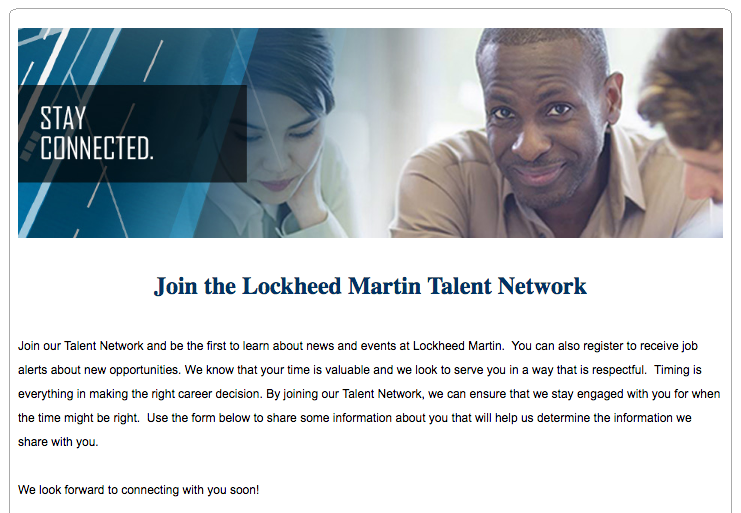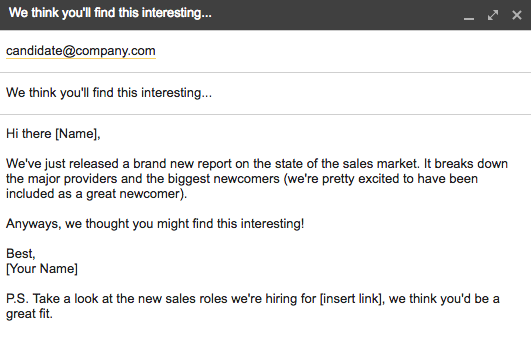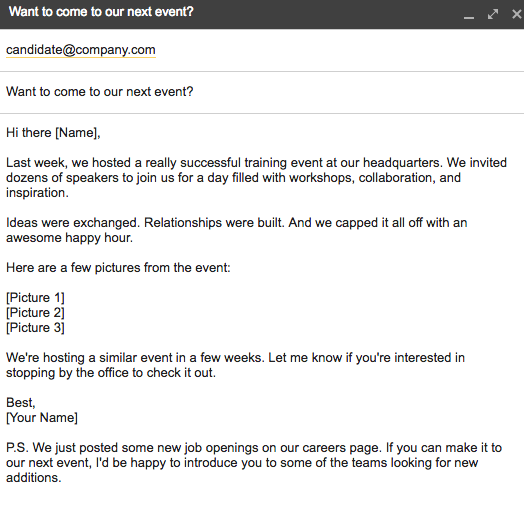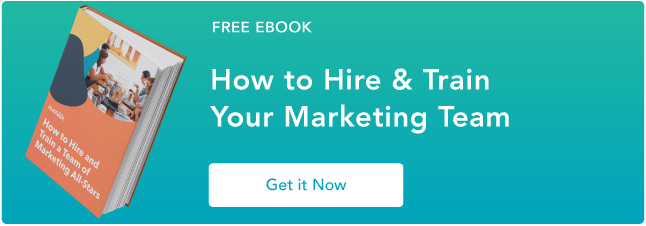
Inbound marketing has fundamentally changed the way most companies think about customer acquisition. By building a relationship with prospects before they’re ready to purchase, companies can acquire customers in a far more cost effective (and efficient) way.
With inbound, companies earn consumer attention through great content, and as a result, it’s easier for them to move leads through the customer lifecycle towards a purchase.
Consistent readers of this blog will be pretty familiar with the value of inbound marketing, but you may be unaware of the full potential of the inbound methodology.
At Beamery, we’ve started thinking about how to apply the inbound framework beyond our marketing efforts. In doing so, we’ve come to realize just how valuable it is to think about hiring in the same way that we think about our marketing efforts.
We’ve seen fire hand exactly how effective this formula is for improving recruiting, which is why we’re sharing our process with you below.
Recruitment vs. Marketing: How Do the Two Compare?
It’s easy to hire with a short-term mindset. In fact, many people reduce it to this simple transaction: Send out a job advert, screen applicants, and make a decision.
You’re probably starting to think that this process sounds a lot like the way companies used to compete for potential customers. Traditional marketing relied on ‘interrupting’ your flow of activity to grab your attention. But these tactics don’t work too well anymore.
As a result, many marketers have changed tack. They’re reaping the rewards of an inbound strategy — one that focuses on building relationships over making a quick buck. And forward-thinking companies are using this framework to build relationships with candidates well before the application.
At a time when getting the very best people through the door is becoming harder and harder, engaging the candidates that don’t apply might be the best way to win the hiring game.
Here’s how to put inbound recruiting into action …
How to Get Started With Inbound Recruiting
1) Create candidate personas.
Creating buyer personas is crucial to every targeted marketing strategy. You need to have a clear picture of who your ideal customer is if you want to craft an effective plan to reach them.
The same applies to recruiting. You need to know who you are really looking for when you have an open role. Forget the job title and the company name, what does your ideal new hire really look like?
Once you’ve established this, you can start thinking about the ways that you can attract this ideal candidate, as well as the kinds of content that they would find valuable.
So how do you go about this? Fortunately, there’s a simple formula to creating your own candidate personas:
- Review your current process. Are you currently attracting quality applicants? How are you currently trying to connect with relevant candidates? Are you using LinkedIn? Is this working?
- Define your company culture. What helps employees succeed at your company? What skills are valuable? What traits do you hold dear? An easy way to gather this information is to survey employees or other stakeholders in the hiring process.
- Create your persona narrative. Use your new definition of company culture –and the traits that you know help people flourish — to put together a persona of your ideal candidate. This persona should be different for each new role that you’re hiring for, but will share some underlying traits.
- Create relevant content. Brainstorm the type of content that your persona would find valuable based on their unique wants, needs, values, and challenges.
- Share your content. Find the best forums to connect with your persona and share your new content. Depending on who you’re looking for, the right forum could be anything from Twitter to online gardening forums.
Ultimately, this candidate-specific content will bring relevant people to your site and introduce them to your brand — the first step towards getting them to apply.
2) Start prospecting to fill the funnel.
Modern sales and marketing is a symbiotic relationship. Sales teams are fed by a steady stream of leads from marketing. It’s the foundation of how online businesses generate customers and revenue.
For sales teams to be successful they need that influx of leads. They need marketers to constantly fill the top of the funnel with interested prospects. However, pipeline isn’t just a revenue requirement — it’s also central to effective recruiting.
In modern talent acquisition, candidates care about where they’re applying. It’s your job to attract them to your brand and make them interested in learning more. Companies need to do more to start relationships with candidates that haven’t applied if they want to build a recruiting pipeline that gives hiring the same predictability as sales.
Case Study: Spotify
Spotify’s recent sponsorship of the Grace Hopper Celebration of Women in Tech is a great example of how to use event marketing to attract qualified candidates.
One of the music service’s key hiring pain points is the ability to attract technical talent, specifically female tech talent. By sponsoring this event, they not only got access to a pool of talented engineers, but also had the chance to make a positive statement in the ongoing debate over women in tech.
But you don’t need the resources of Spotify to get this kind of effect, in fact, you don’t even need to sponsor an event. Instead, try inviting candidates to schedule a Google Hangout with members of your team.
This worked particularly well with one of our customers: They set up a monthly Google Hangout between their head of engineering and all the engineering candidates that they’d encountered that month.
It’s a small time commitment (30 minutes), but the candidates get to ask questions, feel like they’ve been given special treatment, and get insights into what life as an engineer at the company is really like. Needless to say, their application rates (and quality of applicants) have gone through the roof.
3) Create opportunities for micro-conversions.
Many of the people that come to your website are not ready to make a buying decision. This is why calls-to-action and content such as ebooks, whitepapers, and webinars are such widely adopted marketing tactics.
Instead of asking a prospect to make a full conversion (e.g., signup or demo request), you can entice them to make a ‘micro-conversion’ where they exchange their email address for valuable content.
Recruiting is no different. Many people that come to your careers page aren’t ready to apply (yet). After all, applying for a job is a pretty big investment. Sometimes they just want to find out more about your company or learn about relevant opportunities — so make sure you’re making that information readily available and provide them.
Whether you present them with related blog content, point them towards other company resources, or provide them with an opportunity to stay up-to-date with future job openings, providing these alternative options helps to keep them engaged with your brand.
Case Study: Lockheed Martin
Lockheed Martin — a global aerospace, defense, security, and advanced technologies company — offers candidates the option to join their ‘Talent Community’ if they’re not ready to apply. As a result, they’re left with a huge pool of talent to tap into over time.
To join the community, potential applicants must specify their areas of interest, as well a preferred time frame for how often they’d like to be contacted about opportunities. This makes it easy for their team to source the right candidates, for the right jobs, at the right time.

You may not have Lockheed’s resources, but the key thing to learn here is focus. Communities based around a specific skillset or persona, will have a better chance of success than ‘generalized’ ones.
4) Start turning those leads into applicants.
As any great lifecycle marketer will know, getting a prospect’s email address is only the first step. Turning leads into customers can be a lengthy process with numerous different touch points.
Inbound recruiters face the same issue. After they capture contact information for candidates, they still have to sell their company and convince people to apply. In other words, lead nurturing is just as important for recruiters as it is for marketers.
Most companies lean heavily on email marketing for this. Comfortably the most effective tool, it’s 40x more effective than Facebook and Twitter combined for customer acquisition.
Well-timed email is also your best bet when it comes to nurturing your new hiring leads. Keep candidates in the loop about new opportunities that match their skillset, major company news (e.g. funding) and relevant events (e.g. graduate hiring fairs).
It goes without saying that all communication should be targeted. Only sales candidates should receive emails about sales roles. This sounds simple, but it can be the difference between successful nurture and irritating your entire candidate database!
Here’s are a couple of quick examples of the kinds of messages that are effective:
Find something worth sending
If your company has been in the news or released something cool, one of the first things you should do is tell your candidates. Smart people typically want to work at companies that they perceive as successful.

Share your culture
Show candidates what you’re like when you’re not tied to your desk. 56% of people see your culture and brand as the most important thing when they make a job decision.
 As you can see, the best nurturing emails provide candidates with something of value, not just a bunch of different job links.
As you can see, the best nurturing emails provide candidates with something of value, not just a bunch of different job links.
You might not end up hiring everyone you make an effort with, but that’s not the point. Maybe six months down the line a great salesperson will have read another one of your ebooks and changed his mind. Maybe a top engineer has been following your email updates and wants to get involved.
It can take a lot of touch points to influence a decision, so you never know when these relationships will start to pay off. Invest the time in building them now to reap future rewards.
5) Optimize and iterate your recruiting efforts.
It’s pretty rare that new company initiatives take off without a hitch. In fact, there’s usually a little tweaking necessary before things run completely smoothly. This makes a culture of testing and optimisation crucial to success. And the same can be said for your inbound recruiting efforts.
You need to test different content formats to attract candidates. You need to explore different ways to connect with prospective employees. And you need to experiment with different career page designs to encourage visitors to apply.
To get the data you need, you’ll need to lean on your marketing automation software or Google Analytics to track how candidates are finding your content. For example, if your team has been sharing content on LinkedIn, dig into the numbers to see if candidates are clicking through to your site and converting into applicants or new leads. If not, maybe it’s time to try a different approach.
You should also use your analytics platform to determine what content is most effective at turning prospects into applicants. Are there particular landing pages on your careers site that have a higher conversion rate? Are certain job descriptions encouraging more applicants than others?
Make sure you use your learnings here to improve your less effective content –constantly tweaking your approach is the best way to get better results.
However, data only paints part of the story. We recommend asking applicants how they found out about your company, and why they applied. You can add this to your application form as a short question, or ask it in the first interview or screening. This should give you a little more information on what gets people interested in applying.
Ultimately, the key to optimising your inbound recruiting machine is finding a repeatable model. You need to know what kind of content helps you connect with talented people and start producing more of it.
Immerse yourself in the data and you’ll see what works for you.
Getting Started
Inbound marketing has fundamentally changed the way that we acquire customers, so it shouldn’t come as a surprise that it has other applications. Inbound recruiting is a developing area, but if you give it enough attention, you should be able to reap the rewards.
Do you use inbound techniques to fuel your recruiting process? If so, share your ideas in the comments below.







